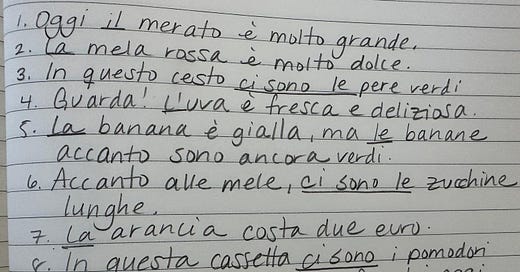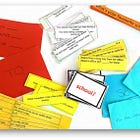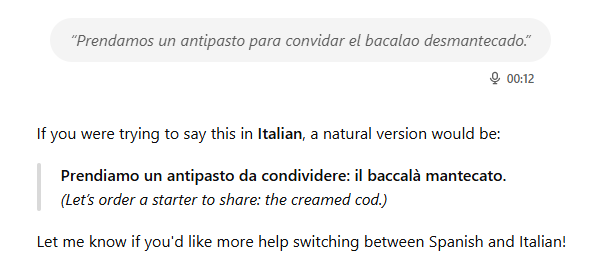A few weeks ago, I found out I’d be going to Italy for a work trip. It felt like a little nudge from the universe to finally put real effort into my goal of learning Italian.
I set a realistic goal and outlined a straightforward plan, focused on meaningful practice. I’ve been using ChatGPT as a “tutor” and working with my Vocabulary Notebook to slow down and retain as much as possible. You can read my original plan here, but here’s a reminder of my goal:
By May 2, I’ll be able to order a meal, have a simple conversation in a hotel, and a basic exchange about public transport.
Today, I want to share what my experience has been like so far, with full transparency, in the hope that it encourages you to explore your own self-study options.
How It’s Going
I "studied" Italian on 7 of the 12 days I had originally planned. Other priorities came up, and that will certainly affect my progress. Still, here’s what I have done:
Used ChatGPT to generate common vocabulary and copied it into my notebook
Built simple, somewhat natural dialogues with ChatGPT using voice mode
Practiced "at the restaurant" conversations over several different days
Asked for help with tricky sounds and letter combinations (like ch/ci, double consonants, gn, etc.)
Learned some basic grammar rules, like forming plurals, and practiced with gap-fill exercises
Binge-watched the Italian series Lidia Poët
Did some slow learning with a song (Felicità-cheesy but fun)
Listened to News in Slow Italian
Takeaways So Far
Practicing Productive Skills Is Key
I still rely heavily on my notebook to produce language, but practicing productive skills (speaking and writing) even at a very basic level has made a huge difference.
Simple things like talking outloud or saying to my husband:
Sono le otto meno un quarto. (It’s 7:45.)
Queste fragole sono deliziose. (These strawberries are delicious.)
I’ve written about this before (see below), but it’s worth repeating: You need to activate what you’re learning. Reviewing vocabulary lists and doing gap-fills is helpful but not enough. Even simple production tasks are essential for building real fluency. Practicing with ChatGPT also helps because there’s no judgment as I slowly build neural pathways.
Cross-Linguistic Influence Is Real
Because Italian is so close to Spanish, my brain sometimes files new Italian words under "already known." This leads to mistakes when I actually try to produce language.
This is normal. Adult learners rely heavily on their previous languages, a phenomenon known as cross-linguistic influence or transfer (Liu, 2022).
Some of this transfer is positive. Mapping Italian onto Spanish and French helps with comprehension and acquisition (González Alonso et al., 2021). But I’ve also seen some negative transfer, especially in pronunciation. Luckily, ChatGPT still "understands" me, even when my Italian sounds suspiciously like a mash-up of French and Spanish.
Why Metalinguistic Knowledge Matters for Self-Study
One thing that has made this Italian project easier is having developed some metalinguistic awareness, which is an understanding about how languages work.
Because I have studied French and Spanish before, I knew right away that I needed to learn things like adjective agreement and noun plurals. As a complete beginner, I might not have spotted those patterns so early.
This kind of awareness has helped know where to focus my attention.
Of course, finding my own grammar points means a lot of ad hoc searching. A textbook or teacher would have presented grammar like this alongside the vocabulary I was learning, and that might have saved time. Still, I like the flexibility of learning grammar as it becomes relevant to me.
If you are self-studying, regularly reflecting on what you need next can make your study time much more efficient. (Here’s a guide to completing an audit of your strategies.)
The Hidden Challenge
I don’t expect language barriers to be a major issue on my trip. In tourist-heavy areas like Venice and the Dolomites, English is widely spoken. Between English, Spanish, hand gestures, and patience, I should be able to navigate cafes and hotels.
What worries me more is whether I’ll actually use my Italian.
Language learning is naturally uncomfortable at times. You make mistakes. You get stuck. Sometimes people do not understand you. Sometimes they get impatient.
It takes a little bit of courage to be a beginner. It’s a challenge I know I’ll face when the time comes to order that first meal or ask for directions.
Let’s hope I manage to push through the hesitation and really use the Italian I’ve worked so hard to learn.
Thank you so much for reading Love to Lingo.🤍 If you find this newsletter to be a useful tool in your language learning kit, please consider buying me a coffee or restacking this post. I sincerely appreciate your support!
If you haven’t already, I also encourage you to check out the ready-made language learning notebooks I’m selling through Amazon (for now). They’re a simple way to keep your learning organized and motivating.
Happy Language Learning!
References
González Alonso, J., Puig-Mayenco, E., Fábregas, A., Chaouch-Orozco, A., & Rothman, J. (2021). On the status of transfer in adult third language acquisition of early bilinguals. PloS one, 16(3), e0247976. https://doi.org/10.1371/journal.pone.0247976
Liu Z. (2022). Mapping the research trends of third language acquisition: A bibliometric analysis based on Scopus. Frontiers in psychology, 13, 1021517. https://doi.org/10.3389/fpsyg.2022.1021517









Molto bene! When I went on holiday in Berlin, I wore a pin that said: "Please be patient with me, I am learning German" to avoid locals helpfully swtiching to English. It worked a bit of they were not in a hurry. If you want to practice Italian, just say it: we are usually very happy when someone tries to speak our language. ☺️